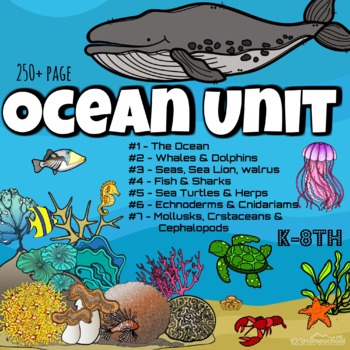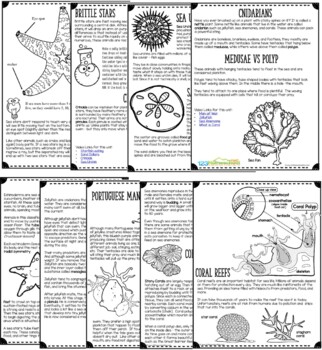Ocean Animals BUNDLE (250 pages!!)
- Zip
What educators are saying
Products in this Bundle (6)
showing 1-5 of 6 products
Bonus
Description
Dive in to this fun Ocean Animals Lesson filled with fascinating information about the oceans, whales, star fish, sharks, and more amazing creatures. You will find engaging text, science experiments, printable worksheets, life cycles, printable crafts, label the anatomy, report templates, creative writing prompts, beautiful color flashcards, and so much more!
This huge, 250+ page Ocean Animals Lesson will allow you to learn about the ocean and aquatic animals. There are 7 units to allow you to more closely examine the wide variety of aquatic animals on our planet - from whales to sea urchin. Use this fun science unit complete with easy to understand information, fun worksheets, video links, science experiments, cute clipart, printable crafts, report templates, creative writing prompts, and tests. This aquatic animals for kids unit has tons of options making it perfect for students in kindergarten, first grade, 2nd grade, 3rd grade, 4th grade, 5th grade, 6th grade, grade 7, and grade 8 - there is truly something for everyone!
This Ocean Unit BUNDLE includes
1 - All About the Ocean - BONUS! (only available in this bundle)
Lesson one will give you an overview of the largest animal habitat - water! 97% of the water in our world is found in the oceans: Pacific, Atlantic, Indian, Southern, and Arctic Oceans. Learn the differences between salt water, fresh water, and brackish water. Discover the continental shelf and abyssal plains. Make ocean currents come alive for kids with some fun science experiments. Get an overview of ocean animals and how they are classified as nektonic, benthic, or sessile. Finally learn how filter feeders clean the water, food chains, and test your knowledge of what you've learned.
2 - All About Whales & Dolphins
Continue learning about the oceans for kids as you learn about the largest animals on earth. Whales have a tongue that weighs more than most cars, a heart as big as a Volkswagen Beetle, and they spend most of their life in parts of the ocean no person can ever see. Even though whales can dive thousands of feet below the surface of the ocean, they are mammals and must breath air just like you and me or they would drown. Join us on a fascinating study about these marine mammals.
In the next of our ocean animals lesson plans you will learn about the marine mammals that have front and rear flippers - seals, true seals, sea lions, and walruses. These animals have big bulky bodies and a thick layer of blubber to keep them warm in cold waters. While their large bodies weigh over 1000 pounds, they are great swimmers. Learn about Harp seal life cycles and walrus life cycles. Then explore the coasts where these large aquatic mammals make their rookeries to bear about one pup a year. Try a science experiment to discover why blubber keeps them warm. In addition to engaging text and worksheets, kids will be excited to make a printable seal craft and play Pinniped BINGO game for review.
4 - All About Sea Turtles & Aquatic Herps
In this lesson you will learn all about herps. Herps are creeping, crawling creatures that move about on their bellies. Learn science terms like ectothermic, oviparous, viviparous, and brumation as you get to know more about sea turtles, sea snakes, frogs, toads, and salamanders. Compare and contrast aquatic amphibians the frog and toad, discover the sea turtle life cycle, label the tadpole anatomy, make a frog life cycle printable craft, fill in worksheets like true and false, color cute coloring pages, look for clues in the text, fill out report templates, use creative writing prompts, and take a test to find out what you've learned.
5 - All About Fish, Sharks, & Rays
Fish come in all shapes, sizes, and colors. Some look like rocks while others look like snakes, some have huge mouths with sharp teeth and others can fly! While we don’t have time to talk about the 28,000 different species of fish scientists know about, we will take a look at the types of features fish have, bony fish, fish defenses, fish shapes, spawning, sharks, and various rays. Did you know that about 40% of sharks will lay the eggs in an egg case called a mermaid's purse? In addition to the interesting facts, tests, worksheets, fish life cycle, shark life cycle, shark anatomy, fish anatomy, coloring pages and more - make a printable shark craft and All About Sharks book.
6 - All About Crustaceans, Mollusks, and Cephalopods
Crustaceans are animals whose bodies are made of segments, a tough outer shell, two pairs of antennae, and limbs that are jointed. Most crustaceans spend a good part of their lives crawling along the bottom of streams, rivers, and the ocean. Learn how their exoskeleton is made of calcium carbonate and eat the layer they molt. Discover their three mouth parts, body parts (including cephalothorax and abdomen), carapace, and 2 sets of antennae. Crustacean animals include lobsters, crayfish, crabs, shrimp, krill, barnacles, and horseshoe crabs.
Mollusks are soft, slimy creatures with squishy bodies. Every seashell you find on the beach was made by a mollusk, but not all mollusks make shells. Learn about the mantle, siphon tubes, pearls, and the animal that drills into other mollusk shells. Some examples of mollusks include snails, slugs, oysters, clams, mussels, sea slugs, and others.
Another type of mollusk in a category of its own is a kids favorite - Cephalopods. You probably know them better as octopus, squid, cuttlefish, and nautilus. These intelligent invertebrates can change colors in a split second, change the shape of their body to fit in small cracks, have three hearts that pump blood, powered by jet propulsion, and even make their own ink.
7 - All About Echinoderms & Cnidarians
Echinoderms are sea animals with spiny skin. Animals in this group include sea cucumbers, feather stars, brittle stars, sea urchins, sand dollars, and starfish. All these spiny-skinned creatures have some things in common: no eyes, no brain, and tube feet. In addition, they have tube feet, radial symmetry, can clone themselves, and many other interesting features.
Cnidarians are boneless, brainless, eyeless, and footless; they mostly are made up of a mouth and tentacles. Some have tentacles that hang below them called medusae, while others wave above them called polyps. Explore the coral reef including jellyfish, sea anemone, coral, and more.





